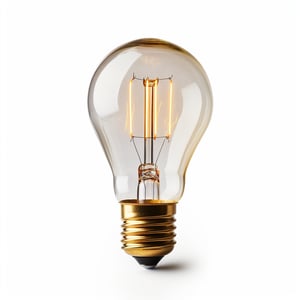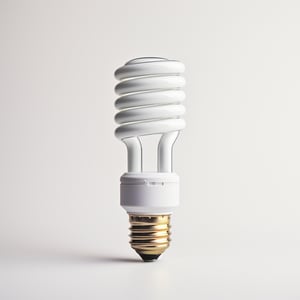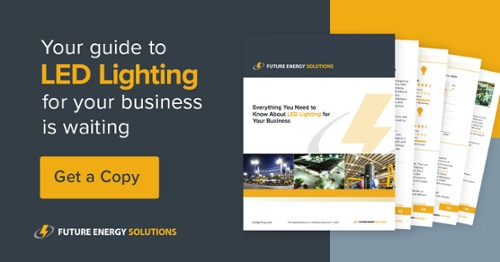Understanding the best types of commercial lighting fixtures can prove critical for your business's success — each can have a major impact on sales, safety, and the perception of your business.
Managing your operating expenses is critical to controlling your bottom line, and lighting is typically the largest line item in your energy budget. Swapping to more energy efficient lighting is one way small businesses are cutting costs.
Astonishingly, nearly 40% of businesses have yet to optimize their lighting solution!! Don't be just another statistic...
The right lighting can drastically improve retail experience, boost productivity, and even affect your employees' mental health. It's not surprising that more businesses are switching to energy-efficient lighting solutions.
But are YOU making the most of your lighting choices?
6 types of commercial lighting fixtures
Depending on your lighting needs, there are different types of commercial lighting that could work well, including:
- Incandescent
- Halogen
- Fluorescent
- Induction
- Metal halide
- LED

Incandescent
Incandescent lighting is one of the top types of commercial lighting used by businesses because it’s:
- Familiar
- Comes in a range of sizes
- Provides warm tones
- Inexpensive to replace.
Unfortunately, it’s also one of the least durable forms of commercial lighting, so bulbs need to be replaced frequently.

For businesses that require adjustable lighting throughout the day, incandescent lighting can be used with dimmers and compatible switches. However, it's worth noting the adjustments are typically done manually. This is because incandescent lighting generally doesn't work with smart systems, unless some type of adapter is used.
Incandescent lights only convert about 5% of the electricity they consume into visible light
Not only do these bulbs have a shorter lifespan, but they also waste a significant amount of energy by emitting heat instead of light, making them of the most wasteful types of lighting available.
Halogen
While slightly more energy efficient than incandescent lighting, halogen lighting really shines when it comes to sustainability.
Halogen bulbs have twice the lifespan and use 25% less energy compared to traditional incandescent bulbs to produce the same amount of light.
They're an excellent choice for task lighting, particularly when you need to concentrate on a task for an extended duration. Moreover, they bear a resemblance to traditional incandescent lighting, making them a suitable option for those who prefer the standard bulb shape.
However, halogen bulbs are generally pricier than other lighting alternatives. Additionally, their high operating temperature necessitates caution by keeping all flammable materials at a safe distance. The noticeable heat they emit makes them unsuitable for prolonged exposure.
Fluorescent
While fluorescent lighting does have its drawbacks, it remains a popular choice among businesses. Not only does it provide slightly better energy efficiency, but it also boasts a longer lifespan compared to halogen and incandescent alternatives.

However, fluorescent lighting does fall short in one important area which is its inability to render colors accurately. This can leave a negative impression on customers, especially in contexts where color tone matters, such as home decorations, clothing, makeup and skincare, and food service.
Fluorescent light sensitivity can cause headaches, nausea and eye strain, making it a significant health concern for many people.
Over time, fluorescent lights also gradually diminish in brightness, necessitating frequent replacement to ensure that critical areas remain well-lit.
Induction
Induction lighting surpasses fluorescent options in terms of light quality, offering exceptional reliability for 24/7 applications with consistent output, like parking structures. Prior to the emergence of viable commercial LED lighting, energy-conscious businesses widely adopted induction lighting.
However, induction lights are not suitable for outdoor use due to reduced efficiency in extreme temperatures.
While relatively bright, induction lights actually have lower output which means that you'll need more of then to properly illuminate a given space. They also require the use of ballasts, which contain significant amounts of mercury.
This can lead to radio frequency interference that can adversely affect other delicate electronic systems in the area. Consequently, businesses now prefer LED commercial lighting due to these concerns.
Metal Halide
While metal halide lamps offer high-quality lighting, their energy efficiency leaves much to be desired. Nevertheless, depending on the specific context, these lamps can still be a favorable choice, thanks to their ability to emit omnidirectional light. This allows for precise targeting of light where it is needed, such as providing task lighting for employees.
However, metal halide lights require a long warm up period to get to full brightness. This can take take up to 15 minutes, depending on the wattage of the bulb.
If metal halide lamps are switched off even momentarily, the warm up period begins again. This creates unnecessary downtime for employees.
Additional reading: commercial lighting for restaurants
LED (the best commercial lighting option!)
The use of commercial LED lighting became widespread in the 1990s, and it has since been embraced by the majority businesses around the world.

With the many benefits of LED lighting in terms of energy efficiency and longevity, it has become a staple choice for many companies in various industries. LED lighting fixtures lead all other types of commercial lighting in terms of lifespan, sustainability, and quality of light.
As of 2018, LED lighting became the second most popular lighting solution for businesses. More than 44% of commercial buildings in the US use some form of LED lighting.
By transitioning to various types of LED lights, businesses can reap the benefits of reduced hardware and energy expenses. With longer lifespans and lower maintenance requirements compared to other commercial lighting options, LED lights offer a cost-effective and more sustainable solution for just about any type of business.
Additional reading: lumens to watts conversion chart
Switch to the best commercial lighting now
Ready to make the switch? At FES Lighting, we understand that transitioning to new lighting systems might seem daunting. Our team of experts is committed to guiding you through the process.
As one of the leading lighting as a service providers in the US, we take pride in our commitment to not only provide high-quality lighting but also maintaining and managing those systems for our clients.
This means you can focus on what matters most – running your business – while we take care of your lighting needs. Our experts can help you with everything from running a commercial energy audit checklist to designing and implementing tailored lighting solutions for your business.
Don't just switch to better lighting, switch to a better lighting experience with FES Lighting. Contact us today to learn more about our services and how we can help guide your business towards a brighter and more sustainable future!
If you’re considering switching to LED lighting for your business, be sure to read this Commercial Guide to LED Lighting.
Which of these commercial lighting types is right for your business?
Selecting the right type of lighting is crucial for any business, be it for energy efficiency, brightness, lifespan, or quality of light. Businesses must consider these factors while choosing their lighting, and the trend towards LED lighting is testament to its multifaceted benefits.
As businesses continue to prioritize sustainability and cost-saving measures, LED lighting has emerged as the clear winner in commercial lighting options. However, it is important for businesses to carefully assess their individual needs and consult with experts before making a decision on which type is right for them.
With the help of a trusted partner like FES Lighting, businesses can make the switch to LED lighting seamlessly and reap its many benefits.
Don't just settle for ordinary lighting – switch to LED and experience the difference today.




%20(1).png?width=1080&height=1080&name=FES-Ebook-1%20(1)%20(1).png)